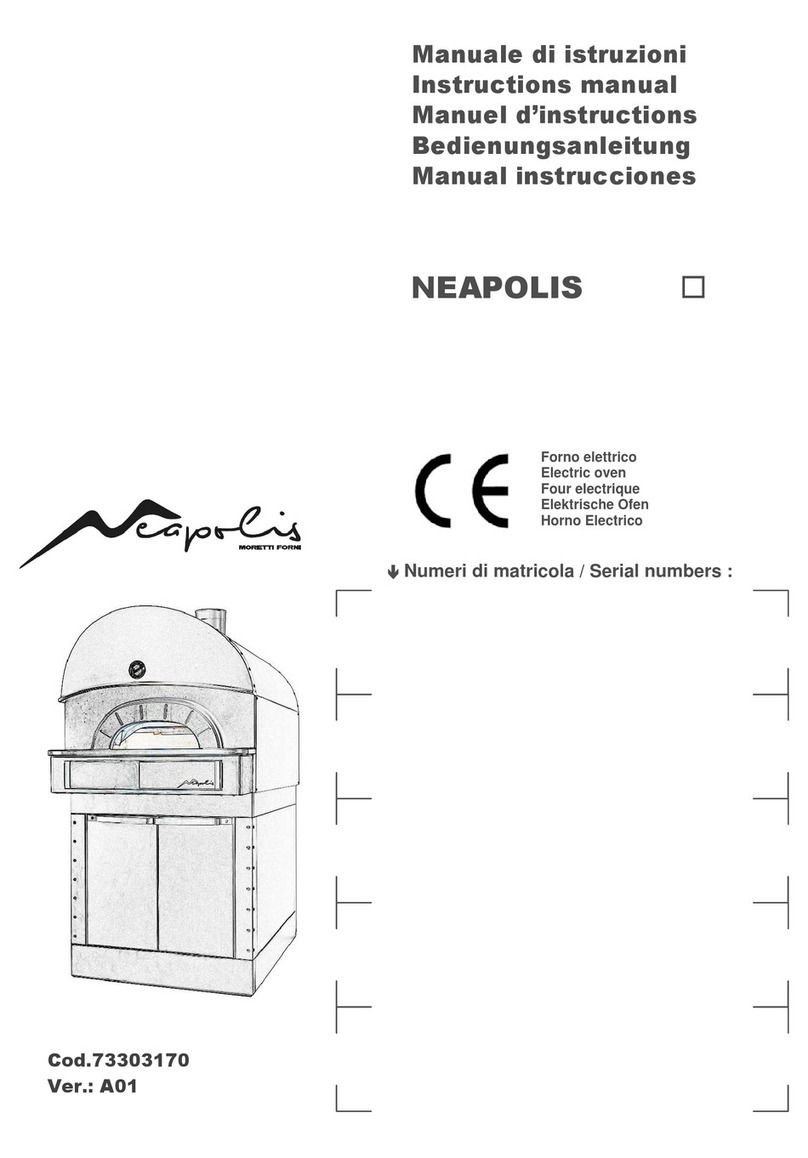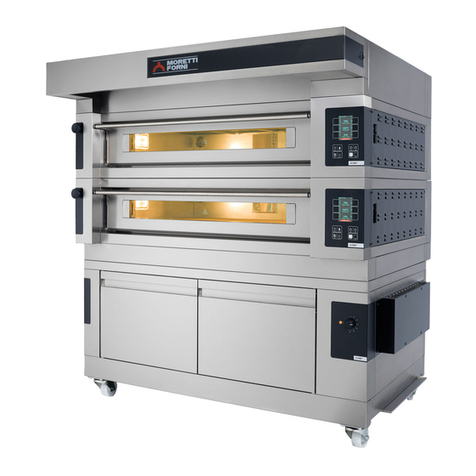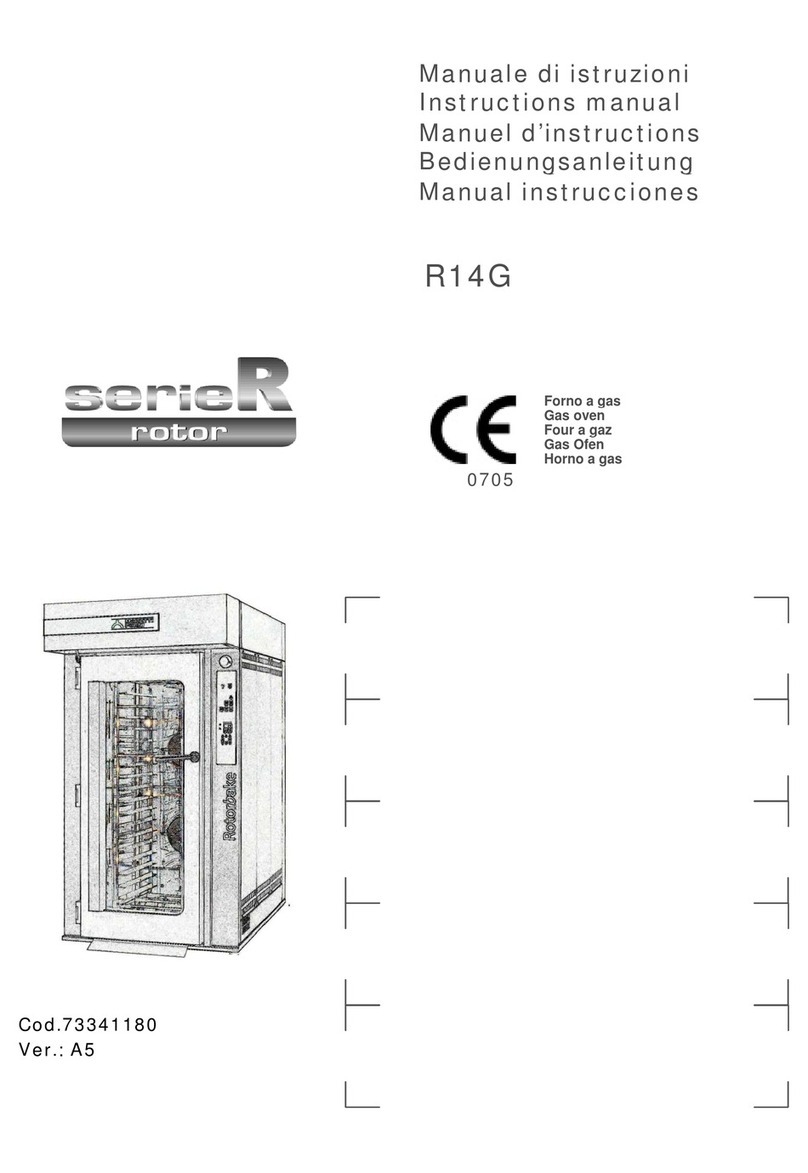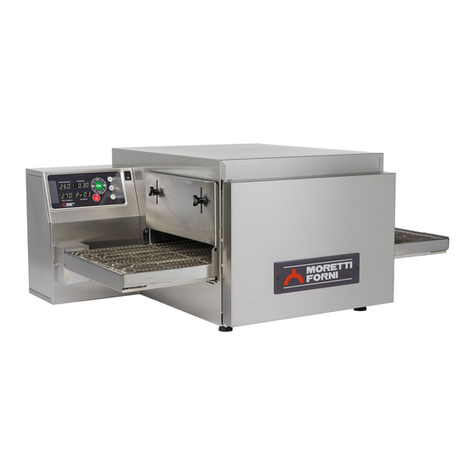
overheating mean that any further use will cause a fire hazard; always
replace the thermocouple (item 32 Plate A).
To restore the oven to normal operation, unscrew the safety thermostat
cap (fig.18 item 2) and press the button underneath it.
The button inside will reset the thermostat, the lower panel will stop
flashing and the oven will start up normally.
Replace the protection cap (fig. 18 item 2) over the safety thermostat to
avoid it being damaged and compromising oven operation.
f) The “Light” button (fig.18 item 6) is used to turn the lighting inside
the baking chamber on and off.
To turn the oven off, merely press the main switch (fig.18 item 1). It is
necessary to wait 5 minutes before relighting the oven.
g) When the oven is turned on again, the control panel will be in the state
as when it was last turned off.
3.2.1 STARTING UP
When starting up the equipment for the first time or after a long period of
disuse, it is essential to carry out the heating procedure as follows:
- Set the temperatures to 60°C (140°F) and leave the chamber to operate
for about 1 hour. If there is a great deal of steam inside the chamber,
open the door for a few minutes to let out the steam and then close it
again.
- Increase the temperature to 90°C (200°F) and leave the chamber
operating for about 2 hours. If there is a lot of steam inside the chamber,
open the door for a few minutes to let it out and then close it again.
- Increase the temperature to 150°C (300°F) and leave the chamber
operating for about 1 hour. If there is a lot of steam inside the chamber,
open the door for a few minutes to let it out and then close it again.
- Increase the temperature to 250°C (480°F) and leave the chamber
operating for about 1 hour. If there is a lot of steam inside the chamber,
open the door for a few minutes to let it out and then close it again.
- Increase the temperature to 350°C (650°F) and leave the chamber
operating for about 1 hour. If there is a lot of steam inside the chamber,
open the door for a few minutes to let it out and then close it again.
- Increase the temperature to 400°C (750°F) and leave the chamber
operating for about 1 hour. If there is a lot of steam inside the chamber,
open the door for a few minutes to let it out and then close it again.
- Wait for the temperature to cool to ambient levels before switching the
oven on again. If there is a lot of steam inside the chamber, open the
door for a few minutes to let it out and then close it again.
This procedure serves to remove any moisture built up inside the oven
during the production, storage and shipping stages.
NOTE: It is possible for the appliance to give off unpleasant odours during
the operations mentioned above. Ventilate the area.
WARNING! Do not open the door for long periods, especially at high
temperatures as there is a risk of scalding or burns from parts close to
the door.
WARNING! Only use the oven for cooking for the first time after
carrying out the above procedures, which are absolutely essential for
perfect operation.
WARNING! Never bake any items the first time that the equipment is
switched on or when it is switched on after a long period of disuse.
NOTE: During following ignitions it is necessary to avoid heatings too
abrupt to extend the life of components. Each time before reaching the
set point of cooking, stand for at least 40 minutes at a temperature
comprised between 120°C (250°F) and 160°C (320°F).
3.3 STARTING UP THE PROOFER
The control panel is located on the front right hand side of the proofer, as
shown in figure 19.
1. Indicator light (ON/OFF).
2. On/off switch for inside light.
3. Start-up and regulation thermostat.
To start the proofer, proceed as follows:
a) Turn the proofer on by turning the thermostat (fig.19 item 3), the
indicator light will come on (fig.19 item 1).
b) Set the temperature required, up to a maximum of 65°C (149°F).
c) To turn the proofer off, turn the thermostat (fig.19 item 3) back to
zero.
WARNING! Do not touch the heating elements; there is a risk of
burning or scalding.
WARNING! The proofer is suitable for heating only covered or
packed food.
3.4 OPERATIONAL CHECK
Once the baking chambers and the proofer are operational, according to
3.2 and 3.3, check that the appliance functions.
Check that the exhaust works correctly.
Check for perfect start-up and the stability of the burner flame.
3.5 TRANSFORMATION AND / OR ADAPTATION
All operations must be carried out by specialised and duly licensed
technicians.
Before connecting to the new gas supply, check that the appliance
supply pressure is the one indicated in Tab.1, and that this pressure is
guaranteed to remain unchanged on a long term basis.
If the supply pressure is outside the values indicated, advise the gas
supply company and do not start up the appliance until the cause has
been identified and eliminated.
To adapt to another type of gas, (for instance from methane to LPG), it is
necessary to replace the nozzle. For this, please consult the “Technical
data TAB.1”.
The nozzles for different types of gas are supplied in a small bag together
with the oven.
For transformation, close the gas tap, raise the front protection (fig.20 item
A) (for the P110GA-A2-A3 it will also be necessary to remove the cover
fig.20 item B), remove the seal on the nozzle, unscrew it from the burner
(fig.21 item C) and replace it with the correct one, sealing the nozzle again
with a drop of red paint.
Remove the seal from the primary air feed opening, adjust the feed
opening (fig.21 item D) so that it is at a distance X= see technical data
TAB.1.
Seal the primary air feed opening again with a drop of red paint.
WARNING! If a transformation or adaptation has been made
according to 3.5, attach the rating plate with corrected data in position
A on top of the previous one (fig.3).
WARNING! On the model P150G, it is not always necessary to
replace the nozzle (see technical data TAB.1) when changing to
another type of gas; in any case, it is necessary to set the gas valve
pressure regulator (fig.17 item C) as described in 3.1.6, so as to
guarantee a valve outlet pressure (fig.17 item B) the same as listed in
the technical details, TAB.1
3.6 CENTIGRADE OR FAHRENHEIT SELECTION
- Pressing and holding down the “light” (fig.18 part.6) and "+ up” (fig.18
part.3) buttons for about 6 seconds will show the current setting for the
temperature unit of measure (“°C”or “°F” ).
- Holding down the buttons for another 6 seconds will change the previous
setting
3.7 STOPPING
Turn the main oven on/off switches (fig.18 item 1) and the proofer
switches (fig.19 item 1) to “off”.
- Disconnect the power supply by turning off the main power switches
outside the oven.
- Turn off the gas tap
4 ORDINARY MAINTENANCE
4.1 PRELIMINARY SAFETY OPERATIONS
WARNING! Before performing any maintenance operation,
disconnect the gas supply by closing the main tap and disconnect the
power supply by turning off the switches fitted on the outside of the
oven and/or the proofer wait for the appliance to cool to room
temperature.
Always use suitable protective equipment (gloves, eyewear... ).
All precautions are of importance to ensure that the oven remains in a
good state, and failure to observe them may result in serious damage
which will not be covered by the warranty.
4.2 CLEANING
Clean the outside parts of the oven every day using a dry cloth (fig.22).
When cleaning the exterior, never use solvents, detergent products
containing chlorine or abrasives, wire wool, brushes or common steel
scrapers.
WARNING! Never clean the oven with direct jets of water or with jets
of water under pressure.
Do not clean the tempered glass doors when they are still hot.
WARNING! Any grease that has spilled during cooking must be
removed from the baking chamber daily, to avoid the risk of possible
explosions.
WARNING! Under no circumstances clean the oven using detergents
that involve a health hazard.
WARNING! When special cleaning operations requiring the oven to
be moved have to be carried out, the following operations must be
performed by specialised personnel: carry out the operations
indicated in point 4.1, disconnect the exhaust pipe, the gas and electric
power supply, remove the oven positioning brackets and release the
brakes on the front wheels, then commence cleaning operations; carry
out the above operations in reverse order to restore the machine to
normal operation.
































